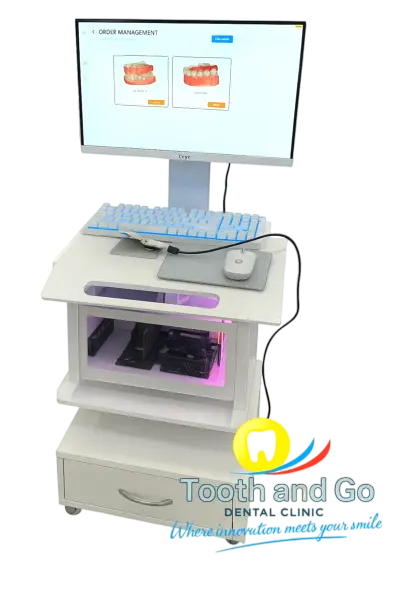Digital dentistry has dramatically boosted the field of dental implantology, offering several key benefits over traditional methods. These benefits not only improve the precision and efficiency of treatments but also enhance patient outcomes and satisfaction. Here’s an overview of its new key features:
1. تحسين الدقة والضبط
Digital intraoral scanners, such as the Cerec Omnicaz m or Panda, and computer-aided design/computer-aided manufacturing (CAD/CAM) systems enable the creation of exact digital impressions and prosthesis designs. Traditional impressions, which rely on physical molds, are technically more sensitive than digital devices. Indeed, digital scans can also be faulty; nevertheless, artificial intelligence is helping to support these devices in correcting possible mistakes. Unlike traditional materials, which don’t forgive errors made by the practitioner, they can be prone to errors caused by patient movement or material setting time. In contrast, digital impressions provide immediate and highly accurate data, indicating to the practitioner right away whether they are usable or not. Based on clinical studies, the accuracy of impressions taken by the digital method was significantly higher than those taken by the conventional method. (Source 1,2,3,4)
2. وقت علاج أسرع
Digital dentistry streamlines many steps of the implant process. Digital scans can be taken within minutes, with an average time of around 1.5 to 2 minutes per arch, whereas traditional impressions may take longer, particularly if multiple attempts are required. Moreover, the use of CAD/CAM technology allows for quicker fabrication of implant crowns or bridges, significantly reducing the time patients must wait for their final prosthesis. In many cases, a single-unit crown (1-3 units) can be fabricated within a single appointment, so that the patient doesn’t have to return for further treatment.

3. تعزيز راحة المريض
مواد الطباعة التقليدية، التي غالبًا ما تكون غير مريحة وتتطلب تدخلاً جراحيًا، قد تُسبب شعورًا بالاختناق أو عدم الراحة للمريض، خاصةً لدى المرضى الذين يعانون من منعكس تقيؤ حساس (عبر العصب اللساني البلعومي). قد يُغني المسح داخل الفم عن الحاجة لهذه المواد، إذ يتطلب ببساطة من المريض العضّ بينما يلتقط الماسح الضوئي صورًا ثلاثية الأبعاد للأسنان والهياكل المحيطة بها.
جينز كناب DMD/MSC سقسقة
يعمل هذا النهج منخفض التدخل على زيادة راحة المريض أثناء إجراءات طب الأسنان ويعزز تجربة المريض بشكل عام.
4. تخصيص التصميم
Modern technologies offer better flexibility in customizing implant prosthetics to meet each patient’s specific anatomical and aesthetic needs. Highly advanced CAD software, such as Exocad Elefsina 3.2 or Exocad Rijeka 3.1, enables designers to create highly humanly adapted crowns, bridgework, and other prosthetic work. The most modern interface of exocad, paired with the newest model of Kavo Arcus Digima, enables the perfect match of occlusal crown surfaces to 3-dimensional, digitally recorded jaw movements, which couldn’t be integrated into dental restorations before.
5. التواصل والتعاون
Cloud-based solutions, such as the Panda Center module of the Panda Scanner System, dramatically facilitate the workflow. In the past, forwarding scan files to the lab was a hassle. However, cloud-based solutions from Sirona Cerec Connect were available, and the sender and recipient were required to own the same software with the exact specifications to receive the files. Nowadays, this isn’t the case anymore; anyone in any location can access scanfiles
6. القدرة على التنبؤ والتخطيط
تتيح الحلول الرقمية لأطباء الأسنان الحصول على سير عمل أكثر دقة
and higher efficiency, enabling more effective treatment planning, as clinicians can utilize 3D imaging to examine the bone structure and surrounding tissues in greater detail. Surgical drill guides can be designed and printed using CAD/CAM technology and 3d printing technology to guarantee an ideal implant positioning. This digital preoperative treatment planning minimizes the risk of complications and enhances the quality of the treatment’s outcome.
7. الفوائد طويلة الأمد
يمكن تنظيم السجلات الرقمية المُنشأة أثناء العلاج وتخزينها والوصول إليها بسهولة للرجوع إليها مستقبلًا. بالإضافة إلى ذلك، يُمكن إعادة إنتاج الملفات والتركيبات بسهولة في حال الحاجة إليها (مثل كسر أو تلف أو فقدان طرف اصطناعي). كما يُمكن إعادة تصنيع النسخ بسهولة، على عكس طب الأسنان التقليدي الذي يتطلب كوادر بشرية كبيرة في حال الحاجة إلى إعادة تركيب طرف اصطناعي.
خاتمة
Overall, digital dentistry significantly surpasses traditional dentistry in terms of accuracy, efficiency, and patient comfort. Nevertheless, there’s much more to expect in the future. Artificial intelligence will likely reduce mistakes that can be avoided through simple theoretical support in treatment planning, the choice of implants, radiographic interpretation, and so on.
Let’s see what the future brings.